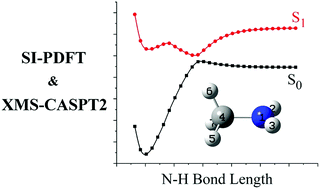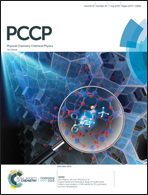State-interaction pair density functional theory for locally avoided crossings of potential energy surfaces in methylamine†
Abstract
The strong couplings between electronic states in conical intersection regions are among the most challenging problems in quantum chemistry. XMS-CASPT2, a second-order multireference quasidegenerate perturbation theory, has been successful in describing potential energy surfaces near the conical intersections. We have recently proposed a less expensive method for this problem, namely state-interaction pair-density functional theory (SI-PDFT), which considers the coupling between electronic states described by multiconfiguration pair-density functional theory (MC-PDFT). Here we test the accuracy of SI-PDFT for closely coupled potential energy surfaces of methylamine along five different reaction paths for N–H bond fission. We choose paths that pass close to a conical intersection of the ground and first excited states. We find that SI-PDFT predicts potential energy curves and energy splittings near the locally avoided crossing in close proximity to those obtained by XMS-CASPT2. This validates the method for application to photochemical simulations.

- This article is part of the themed collections: Celebrating our 2021 Prizewinners and 2019 PCCP HOT Articles


 Please wait while we load your content...
Please wait while we load your content...